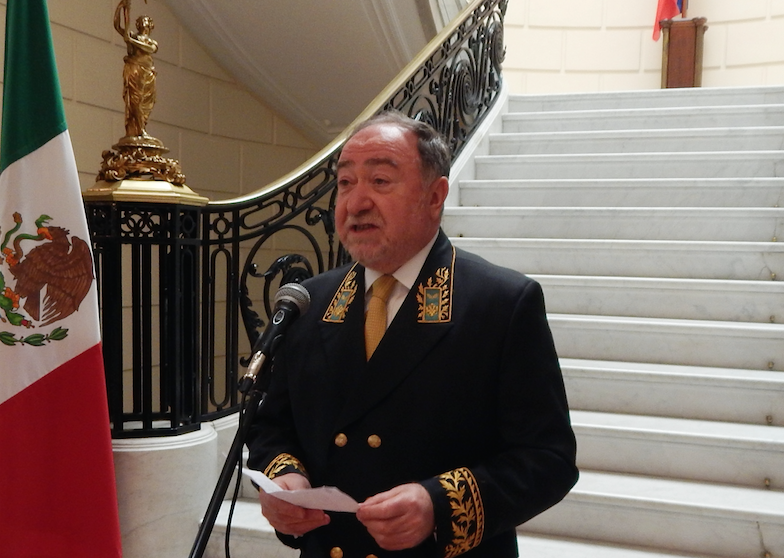When Russian Ambassador Eduard Rubénovich Malayán hosted his annual Diplomats Day reception at his embassy last month, he spoke about the role of diplomacy in today’s world.
Malayán said that, given the current state of global affairs, “it is abundantly clear that the need for diplomacy is greater than ever before.”
“The situation in the world is far from simple,” he said, without making any specific reference to Russia’s ongoing conflict with Europe over its occupation of parts of Ukraine.
The common threats for all nations are mounting, and require the shared efforts of the international community.”
— Eduard Rubénovich Malayán, Russian ambassador to Mexico
But what exactly is the role of a diplomat in today’s world, where direct-line phone calls – or even Whatsapp messaging – between heads of state seems to have replaced the need for personal emissaries and ambassadorial go-betweens? And what will its role be tomorrow?
The answer is not easy because like the international world itself, the art of diplomacy is constantly changing as international relations evolve and the perception of threats to peace and global security are altered.
Peacekeeping, peacemaking and the building and maintenance of security have always been and will always be the core objective of the wider diplomatic and political exercise.
In a world where terrorism threatens virtually every nook and corner of human existence, diplomacy involves must now involve diplomatic skills and new methods of approach, as well as the adoption of innovative strategies to achieve the ultimate objective of peace, something that can best be described as preventive diplomacy.

In today’s world, even the concept of peace has been redefined to mean more than just the traditional notion of absence of war. It is the ability to create pathways for alternative solutions to military actions.
By the same token, the forums in which diplomacy takes place have also changed. Multilateral venues and mechanisms such as the United Nations and G-20 have replaced traditional bilateral encounters.
Regional organizations open new corridors more cooperation and interchange.
These changes in the approach and style of diplomacy have contributed to a need for a substantial and far-reaching revamping of the profession of “the art of the possible.”
During the Cold War era, with its sharply demarcated ideological barriers and rigid strategic concerns, diplomats wear constrained by imposed political constraints and restricted inside the confines of a bipolar world.
When the Soviet Union collapsed in the late 1980s and former enemies became uncertain allies, new opportunities – and hurdles – developed for the erstwhile diplomat.
Many ambassadors adopted new roles, becoming cultural envoy, business promoters and public relations faux pas-menders.
Diplomacy, once a discrete profession practiced in seclusion behind closed doors, is today scrutinized by the media, and every word uttered by or action taken by a diplomatic becomes public fodder for debate.
Diplomacy is under constant scrutiny and criticism, which only makes the art of finding amiable solutions to unamiable conflicts all the more difficult.
There are those who believe that in today’s world, diplomats are anachronisms, relics of a bygone era.
But, as Ambassador Malayán (who was dressed to the nines at his annual Diplomats Day reception in full diplomatic regalia and his official ambassadorial uniform – a holdover from the glory days of pompous protocol and circumstantial diplomatic courtesies) so astutely pointed out, the role of today’s diplomat – albeit a different one from what it may have been a century or even a decade ago – is more crucial than ever.

At the core, a diplomat’s job is the same: to find peaceful resolutions to differences in order to avoid military escalation of political or territorial disputes.
Using words instead of weapons, diplomats can help to weave the fabric of global understanding and cooperation.
No doubt, there are those who could easily attack Malayán on grounds that it is hypocritical for a Russian ambassador to speak about the virtues of diplomacy while his government continues to occupy Ukraine through military aggression and annexation.
But while Ukraine is justifiably enraged by the occupation, it is worth noting that Europe and the West have maintained an open dialogue with Moscow regarding Russia’s withdrawal from Crimea, rather than pursuing a military approach.
And as long as there is dialogue, there is hope for a peaceful resolution.
Talk may be cheap, but it is a much better option than gunboats.
Despite all the changes that diplomacy has undergone in recent years, it is still a slow and tedious process.
But as Malayán so astutely pointed out, diplomacy is the only way viable alternative to military solutions to conflict.
Thérèse Margolis can be contacted at [email protected].










